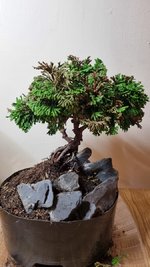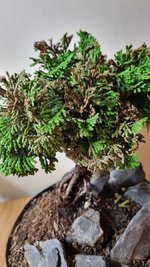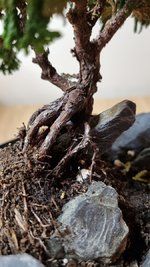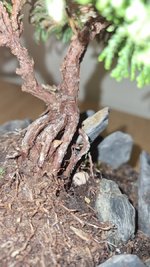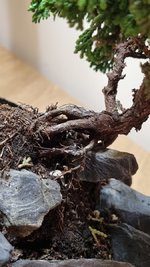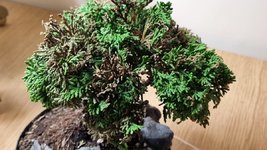Aneesa10511
Seed
- Messages
- 1
- Reaction score
- 0
Hi!
So im pretty experienced with atlantic cypress in my own time having grown bonsai - but ive recently been given a small tree by a friend who was struggling to care for it. They've told me it was sold to them as 'Chamaecyparis Obtusa - Hinoki cypress / Juniper' to be kept indoors (we're in England), and I can't say I'm entirely sure how to deal with it myself so would appreciate some help.
The trunk of the tree has traces of white over it, they're difficult to see but I've tried to photograph them.
And next, a lot of the foliage is turning brown or a greyish shade - I'm unsure if it's normal for this tree to brown during the winter? Again, I've attached pictures.
It's currently in a plastic training pot and I'd thought I'd wait to repot it until spring, there's a lot of fine roots visible through the soil. Im keeping it just damp as I do my other trees, and added a few fertiliser pellets. And I'd just appreciate some help on where to go from here x.
So im pretty experienced with atlantic cypress in my own time having grown bonsai - but ive recently been given a small tree by a friend who was struggling to care for it. They've told me it was sold to them as 'Chamaecyparis Obtusa - Hinoki cypress / Juniper' to be kept indoors (we're in England), and I can't say I'm entirely sure how to deal with it myself so would appreciate some help.
The trunk of the tree has traces of white over it, they're difficult to see but I've tried to photograph them.
And next, a lot of the foliage is turning brown or a greyish shade - I'm unsure if it's normal for this tree to brown during the winter? Again, I've attached pictures.
It's currently in a plastic training pot and I'd thought I'd wait to repot it until spring, there's a lot of fine roots visible through the soil. Im keeping it just damp as I do my other trees, and added a few fertiliser pellets. And I'd just appreciate some help on where to go from here x.

